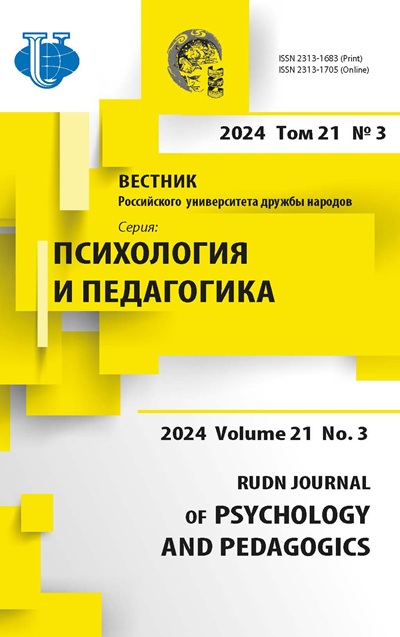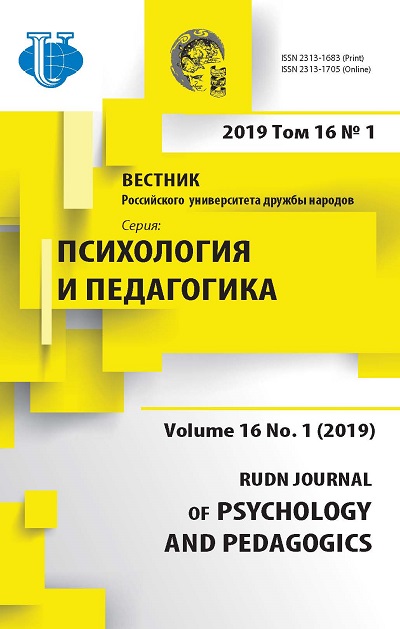Relations of Sensorimotor Integration and Inhibitory Processes with Internal Position of Patient’s Personality
- Authors: Elnikova O.E1, Merenkova V.S1
-
Affiliations:
- Bunin Yelets State University
- Issue: Vol 16, No 1 (2019)
- Pages: 39-54
- Section: CLINICAL PSYCHOLOGY AND PSYCHOPHYSIOLOGY
- URL: https://journals.rudn.ru/psychology-pedagogics/article/view/20826
- DOI: https://doi.org/10.22363/2313-1683-2019-16-1-39-54
Cite item
Full Text
Abstract
The article discusses the relations of the sensorimotor integration and inhibitory processes with the features of the internal position of the patient’s personality. Sensorimotor integration is considered as a characteristic of the mental processes, allowing us to estimate the peculiarities of the flexible rearrangements in the brain in the course of the formation of the new connections. Inhibitory control is considered as a psychophysiological characteristic responsible for cognitive inhibition and suppression of a certain type of behavior. The respondents were voluntary participants (a total of 98 people, 60 women and 38 men) with different levels of health, namely: (1) chronically ill (health group 3) - the total number of 50 people (average age 37 ± 11.1 years); (2) healthy people with certain functional abnormalities - 48 people (average age 34 ± 10.6 years). The types of attitudes to the disease were measured with the TOBOL inventory by L. Vasserman et al. The ReBOS technique by E. Vergunov was used to diagnose the orderliness of the sensory flow and the inhibitory processes level. It is shown that the representatives of the second and third health groups are diagnosed with an identical set of types of attitude to the disease, which is not constructive. That allowed us to divide them into groups according to the degree of adaptation. The respondents, whose mental and social adaptation is not impaired, are more difficult to adapt to the changing conditions, they have recorded rigidity and insufficient development of the inhibitory processes, they are capable of purposefully following the chosen model of behavior, but the underdevelopment of the inhibitory processes does not allow them to stop the implementation of the non-constructive attitude to health. In the respondents, whose type of response to the disease is characterized by the presence of mental maladaptation, the nervous system is more flexible and the inhibitory processes are better developed, they are able to purposefully follow the selected attitude to the disease, and are able to “slow down” the implementation of the chosen strategy. At the same time, the respondents are focused on their own condition, which prevents them from exercising conscious inhibitory control. The results suggest that the perception of the sensory flow and the level of inhibitory processes are related to the internal position of the individual, but the nature of the connections is determined by the degree of the constructive attitude to the disease.
About the authors
Oksana E Elnikova
Bunin Yelets State University
Author for correspondence.
Email: eln-oksana@yandex.ru
Ph.D. in Psychology, Associate Professor, Associate Professor of Psychology and Psichophysiology Department, Bunin Yelets State University
28/1 Kommunarov St., Yelets, 399770, Russian FederationVera S Merenkova
Bunin Yelets State University
Email: krakovv@mail.ru
Ph.D. in Psychology, Associate Professor, Associate Professor of Psychology and Psichophysiology Department, Bunin Yelets State University
28/1 Kommunarov St., Yelets, 399770, Russian FederationReferences
- Aydarkin, E.K. (2005). Issledovaniye osobennostey vzaimodeystviya zritel’noy i slukhovoy sistem v usloviyakh sensomotornoy integratsii. Problemy neyrokibernetiki. Conference Proceedings (vol. 1, pp. 125—128). Rostov-on-Don: OOO “TSVVR” Publ. (In Russ.)
- Ananyev, V.A. (2006). Vvedeniye v psikhologiyu zdorov’ya. In V.A. Ananyev, & S.A. Kulakov (Eds.). Integrativnyye issledovaniya v klinicheskoy psikhologii: nauka i praktika (pp. 64—82). Saint Petersburg: Strategiya budushchego Publ. (In Russ.)
- Chuprikova, N.I. (1995). Vremya reaktsii i intellekt: pochemu oni svyazany. Voprosy psikhologii, (4), 65—114. (In Russ.)
- Darenskaya, N.G., Ushakov, I.B., Ivanov, I.V., Nasonova, T.A., Esaulenko, I.E., & Popov, V.I. (2004). Ekstrapolyatsiya eksperimental’nykh dannykh na cheloveka: printsipy, podkhody, obosnovaniye metodov i ikh ispol’zovaniye v fiziologii i radiobiologii: manuscript. Voronezh. (In Russ.)
- Demakova, O.A., & Sherstyanykh, V.A. (2004). Zavisimost’ vremeni prostoy zritel’no-motornoy reaktsii ot latentnogo perioda pred”yavleniya stimula i urovnya funktsional’nogo napryazheniya. Biologiya — nauka XXI veka. Conference Proceedings (p. 109). Pushchino. (In Russ.)
- Drake, K., Belsky, J., & Fearon, R.M.P. (2014). From early attachment to engagement with learning in school: The role of self-regulation and persistence. Developmental Psychology, 50(5), 1350—1361.
- Endrikhovskiy, S.N., Shamshinova, A.M., & Sokolov, E.N. (1996). Vremya sensomotornoy reaktsii cheloveka v sovremennykh psikhofizicheskikh issledovaniyakh. Sensornye sistemy, 10(2), 13. (In Russ.)
- Feygenberg, I.M. (2008). Bystrota motornoy reaktsii i veroyatnostnoye prognozirovaniye. Fiziologiya cheloveka, 34(5), 51—62. (In Russ.)
- Gamble, A.L., & Rapee, R.M. (2009). The Time-Course of Attentional Bias in Anxious Children and Adolescents. Journal of Anxiety Disorders, 23(7), 841—847.
- Kanzhina, N.N., & Gribanov, A.V. (2009). Audiomotornyye reaktsii u detey mladshego shkol’nogo vozrasta s raznym urovnem trevozhnosti. Ekologiya cheloveka, (10), 19—22. (In Russ.)
- Kaunhoven R.J., & Dorjee, D. (2017). How does mindfulness modulate self-regulation in pre-adolescent children? An integrative neurocognitive review. Neuroscience and Biobehavioral Reviews: Accepted Manuscript, 74(Part A), 163—184. doi: 10.1016/j.neubiorev.2017.01.007
- Korobeynikova, I.I. (2000). Parametry sensomotornykh reaktsiy, psikhofiziologicheskiye kharakteristiki, uspevayemost’ i pokazateli EEG cheloveka. Psikhologichiskii zhurnal, 21(3), 132—136. (In Russ.)
- Mukhina, V.S. (2017). Lichnost’: mify i real’nost’ (Al’ternativnyy vzglyad. Sistemnyy podkhod. Innovatsionnyye aspekty). Moscow: National Book Center Publ. (In Russ.)
- Nekhoroshkova, A.N., & Gribanov, A.V. (2011). Osobennosti zritel’no-motornykh reaktsiy detey 8—11 let s vysokim urovnem trevozhnosti. Ekologiya cheloveka, (5), 43—48. (In Russ.)
- Nekhoroshkova, A.N., Gribanov, A.V., & Deputat, I.S. (2015). Sensomotor reactions in psychophysiological studies (Review). Journal of Medical and Biological Research, (1), 38—48. (In Russ.)
- Nikolayeva, E.I. (2016). Predskazaniya detstva: vozmozhen li prognoz zdorov’ya vzroslogo, osnovannyy na izuchenii dannykh razvitiya rebenka (na primere longityudnykh issledovaniy). Meditsinskaya psikhologiya v Rossii, 2(37). http://mprj.ru (accessed: 04.12.2018). (In Russ.)
- Moffitt, T.E. (2012). Childhood self-control predicts adult health, wealth, and crime. Paper presented at the Multi-Disciplinary Symposium Improving the Well-Being of Children and Youth. Copenhagen.
- Nikolaeva, E.I., Shirokova, I.V., & Vergunov E.V. (2018). The ratio of working memory and parameters of sensorimotor integration in the go-go paradigm in children 7—8 years old. International Journal of Psychophysiology, 131(S), S61. doi: 10.1016/j.ijpsycho.2018.07.182
- Nikolaeva, E.I., Novikova, A.V., & Vergunov, E.G. (2018). The correlation between intelligence, creativity and the parameters of sensorimotor integration in children of different ages. Psychology in Russia: State of the Art, 11(2), 68—80. doi: 10.11621/pir.2018.0206
- O’Toole, S.E., Monks, C.P., & Tsermentseli, S. (2016). Executive function and theory of mind as predictors of aggressive and prosocial behavior and peer acceptance in early childhood. Social Development, 26(4), 907—920. doi: 10.1111/ sode.12231
- Ordaz, S.J., Foran, W., Velanova, K., & Luna, B.(2013). Longitudinal growth curves of brain function underlying inhibitory control through adolescence. Journal of Neuroscience, 33(46), 18109—18124. doi: 10.1523/JNEUROSCI.1741-13.2013
- Savion-Lemieux, T., & Bailey, J.A., & Penhune, V.B. (2009). Developmental contributions to motor sequence learning. Experimental Brain Research, 195(2), 293—306. doi: 10.1007/s00221-0091786-5
- Tarasova, A.F., Seliverstova, N.V., & Zhdankina,L.V. (2000). Issledovaniye vremeni prostoy i slozhnoy akustikomotornoy reaktsii uchashchikhsya. Fiziologiya i psikhofiziologiya motivatsiy (vol. 4, pp. 52— 54). Voronezh. (In Russ.)
- Tough, P. (2012). How children succeed. Boston: Houghton Mifflin Harcourt.
- Vasserman, L.I., Iovlev, B.V., Karpova, E.B. & Vuks, A.Ya. (Eds.) (2005). Psikhologicheskaya diagnostika otnosheniya k bolezni. Manual for Physicians. Saint Petersburg: V.M. Bekhterev Psychoneurological Research Institute Publ. (In Russ.)
- Vergunov, E.G. (2018). Lateralnye predpoctenia kak vozmoznye fenotipiceskie prediktory rezervov serdecno-sosudistoj sistemy i osobennosti sensomotornoj integracii u alpinistov. Fiziologiia cheloveka, 44(3), 97—108. (In Russ.)
- Zaytsev, A.V., Lupandin, V.I., & Surnina, O.E. (1999). Vozrastnaya dinamika vremeni reaktsii na zritel’nyye stimuli. Fiziologiya cheloveka, 25(6), 34—37. (In Russ.)
















